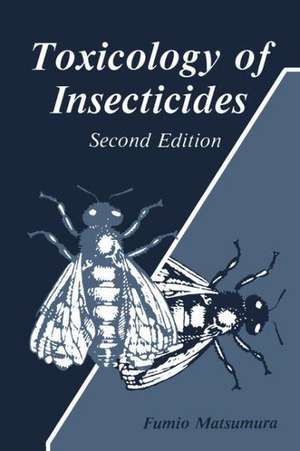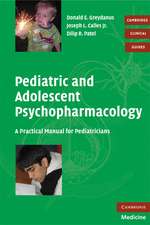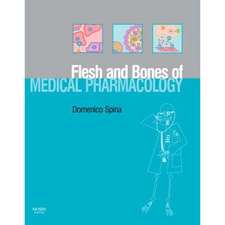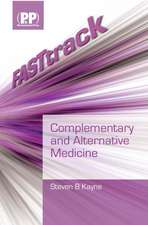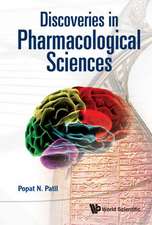Toxicology of Insecticides
Autor Fumio Matusmuraen Limba Engleză Paperback – 21 sep 2011
Preț: 1110.52 lei
Preț vechi: 1168.98 lei
-5% Nou
Puncte Express: 1666
Preț estimativ în valută:
212.55€ • 221.06$ • 178.12£
212.55€ • 221.06$ • 178.12£
Carte tipărită la comandă
Livrare economică 13-27 martie
Preluare comenzi: 021 569.72.76
Specificații
ISBN-13: 9781461295082
ISBN-10: 1461295084
Pagini: 624
Ilustrații: XXII, 598 p.
Dimensiuni: 152 x 229 x 33 mm
Greutate: 0.82 kg
Ediția:Softcover reprint of the original 1st ed. 1985
Editura: Springer Us
Colecția Springer
Locul publicării:New York, NY, United States
ISBN-10: 1461295084
Pagini: 624
Ilustrații: XXII, 598 p.
Dimensiuni: 152 x 229 x 33 mm
Greutate: 0.82 kg
Ediția:Softcover reprint of the original 1st ed. 1985
Editura: Springer Us
Colecția Springer
Locul publicării:New York, NY, United States
Public țintă
ResearchDescriere
The most rewarding aspect of writing a book is receiving encouraging comments from one's colleagues, since one always wonders whether fair coverage was made of the work of others or whether some omissions were made. I feel very fortunate that many colleagues took the time to read the first edition of this book and chose to use it as a textbook in their teaching. During the past few years they have given me valuable suggestions by pointing out areas that needed to be added to improve the book. Toxicology is one of the fastest moving scientific fields. In the areas of insecticide toxicology many new advances have been made since this treatise first appeared. Therefore, it would not be easy to write even a review paper that would not be outdated by the time it was published. In revising this volume I have made a conscious effort to adhere to the basic principles which have been developed over the years. While I have retained the basic framework of the original book, advances that fundamentally change certain concepts or add a new horizon have been chosen for updating those fields where applicable. The main emphasis has been placed on the addition of new sections and new compounds developed since 1975. Since the first edition appeared, several books covering technical details in each group have been published. They are excellent encyclopedic resources in their chosen areas, and are listed in each section as recommended reading material.
Cuprins
1 Introduction.- 1.1. Toxicology.- 1.2. Pesticide Use Patterns.- 1.3. References.- 2 General Principles of Insecticide Toxicology.- 2.1. Evaluation of Toxicity.- 2.1.1. Toxicity Tests against Insects and Other Invertebrates.- 2.1.1a. Graphical Method for Estimating LD50.- 2.1.1b. Goodness of Fit (?2 Test) and Confidence Limit.- 2.1.1c. Symptomatological Observation.- 2.1.2. Toxicological Evaluation in Higher Animals.- 2.1.2a. Selection of Test Animals.- 2.1.2b. Acute Toxicity Data.- 2.1.2c. Chronic Toxicity and Other Nonacute Toxicity Tests.- 2.1.2d. Observation of Toxic Symptoms.- 2.2. Analytical Methods for Insecticides.- 2.2.1. Chromatographic Analysis of Insectide Residues.- 2.2.1a. Sampling, Extraction, and Cleanup.- 2.2.1b. Separation and Detection of Residues.- 2.2.2. Other Confirmatory Techniques for Residue Analysis.- 2.2.2a. Chemical Reactions.- 2.2.2b. Spectroscopic Methods.- 2.2.2c. Biological and Biochemical Assay.- 2.2.2d. Ames Test: A Mutagenicity Test Designed for the Carcinogenic Potential of Chemicals.- 2.3. References.- 3 Classification of Insecticides.- 3.1. History and General Groupings of Insecticidal Compounds.- 3.2. Chlorinated Hydrocarbon Insecticides.- 3.2.1. DDT and Its Analogues.- 3.2.2. Benzene Hexachloride.- 3.2.3. Cyclodiene Compounds.- 3.3 Organophosphorus Insecticides.- 3.3.1. Pyrophosphates and Related Compounds.- 3.3.2. Phosphorohalides and Cyanides.- 3.3.3. Dialkylarylphosphates, Phosphorothioates, and Phosphorodithioates.- 3.3.4. Trialkylphosphates and Thiophosphates.- 3.4. Carbamate Insecticides.- 3.4.1. Naphthylcarbamates.- 3.4.2. Phenylcarbamates.- 3.4.3. Heterocyclic Dimethylcarbamates.- 3.4.4. Heterocyclic Methylcarbamates.- 3.4.5. Oximes.- 3.5. Thiocyanate Insecticides.- 3.6. Dinitrophenols.- 3.7. Fluoroacetate Derivatives.- 3.8. Acaricidal Chemicals: Sulfonates, Sulfones, Sulfides, and Nitrogen-Containing Compounds.- 3.9. Fumigants.- 3.10. Inorganic Insecticides.- 3.10.1. Arsenicals.- 3.10.2 Inorganic Fluorides.- 3.11. Botanical Insecticides.- 3.11.1. Nicotinoids.- 3.11.2. Rotenoids.- 3.11.3. Pyrethroids.- 3.11.3a. Pyrethrum.- 3.11.3b. Synthetic Pyrethroids.- 3.12. Synergists.- 3.13. Hormone Mimics.- 3.14. Inhibitors of Cuticle Formation.- 3.15. Microbial Insecticides.- 3.16. References.- 4 Modes of Action of Insecticides.- 4.1. Introduction.- 4.2. Classification of Insecticides by Their Actions.- 4.3. The Nervous System.- 4.3.1. Mammalian Nervous System.- 4.3.1a. The Somatic System.- 4.3.1b. The Autonomic Nervous System.- 4.3.1c. The Electric (Axonic) Condition of Nerve Impulses.- 4.3.1d. The Chemical Transmission of Nerve Impulses.- 4.3.2 Insect Nervous System.- 4.4. Chlorinated Hydrocarbon Insecticides.- 4.4.1 DDT and Its Analogues.- 4.4.1a. Symptomatology and Characteristics.- 4.4.1b. Action of DDT on Nerves and Theories of Its Mode of Action.- 4.4.1c. Theories of Structure-Toxicity Relationships.- 4.4.2. ?-BHC (Lindane).- 4.4.2a. Symptomatology.- 4.4.2b. Theories of Structure-Toxicity Relationships.- 4.4.3. Cyclodiene Insecticides.- 4.4.3a. Symptomatology.- 4.4.3b. Theories of Structure-Toxicity Relationships.- 4.5. Naturally Occurring Botanical Insecticides.- 4.5.1. Pyrethroids and Synergists.- 4.5.2. Nicotinoids.- 4.5.3. Rotenoids.- 4.6. Organofluorine Compounds: Fluoroacetate and Its Analogues.- 4.7. Anticholinesterases: Organophosphorus and Carbamate Insecticides.- 4.7.1. Organophosphorus Compounds.- 4.7.1a. Symptoms.- 4.7.1b. Inhibition.- 4.7.1c. Recovery.- 4.7.1d. Aging.- 4.7.2. Carbamates.- 4.7.2a. Action.- 4.7.2b. Symptoms.- 4.8. Inhibitors of Respiratory Enzymes.- 4.8.1. Inhibitors of the Electron Transport System.- 4.8.2 Inhibitors of Oxidative Phosphorylation.- 4.9. Inhibitors of Mixed-Function Oxidases.- 4.10. Chlordimeform and Its Analogues.- 4.11. Avermectins.- 4.12 Inhibitors of Chitin Synthesis.- 4.12.1 Assay Systems.- 4.12.2 Studies on the Mode of Action of Diflubenzuron and Other Chitin Synthesis Inhibitors.- 4.13. Use of Physicochemical Parameters for Analysis of Structure-Activity Relationships.- 4.14. References.- 5 Metabolism of Insecticides by Animals and Plants.- 5.1 General Types of Metabolic Activities.- 5.2 Primary Metabolic Processes.- 5.2.1. Oxidation through Mixed-Function Oxidase Systems.- 5.2.2. Reduction.- 5.2.3. Hydrolytic Processes: Metabolism of Esters and Ethers.- 5.2.4. Glutathione-Mediated Metabolism.- 5.2.4a. Glutathione-Catalyzed Metabolism.- 5.2.4b. Glutathione S-Transferases.- 5.3. Conjugation Systems: Secondary Metabolic Processes.- 5.3.1. Glucuronide or Glucuronic Acid Conjugation.- 5.3.2. Sulfate Conjugation or Ethereal Sulfate Synthesis.- 5.3.3. Glycine Conjugation or Hippuric Acid Synthesis.- 5.3.4. Cysteine Conjugation or Mercapturic Acid Synthesis.- 5.3.5. Histidine, Lysine, and Glutamine Conjugation.- 5.3.6. Glucoside Formation.- 5.3.7. Cyanide-Thiocyanate Detoxification.- 5.3.8. Methylation.- 5.3.9. Acetylation and Coupling with CoA.- 5.3.10. Glutathione Conjugations.- 5.3.11 Other Examples and Possibilities of Conjugations.- 5.4. Metabolic Reactions Characteristic of Each Group of Insecticidal Chemicals.- 5.4.1. Chlorinated Hydrocarbon Insecticides.- 5.4.1a. Dehydrochlorination.- 5.4.1b. Reductive and Hydrolytic Dechlorination.- 5.4.1c. Oxidative Reactions.- 5.4.1d. Metabolism of Aliphatic Chlorinated Hydrocarbons: Fumigants and Metabolic Fragments.- 5.4.le. Metabolism of Halogenated Aromatic Compounds.- 5.4.1f. DDT Metabolism.- 5.4.1g. Methoxychlor Metabolism.- 5.4.1h. BHC Metabolism.- 5.4.1i. Aldrin and Dieldrin Metabolism.- 5.4.1j. Isodrin and Endrin Metabolism.- 5.4.1k. Metabolism of Heptachlor and Chlordane Analogues.- 5.4.1l. Endosulfan Metabolism.- 5.4.2 Metabolic Reactions Specific to Organophosphates.- 5.4.2a. General Reactions.- 5.4.2b. Enzyme Systems Involved in the Degradation of Organophosphates.- 5.4.2c. Schradan and Dimefox Metabolism.- 5.4.2d. Trichlorfon, Dichlorvos, and Naled Metabolism.- 5.4.2e. Bidrin®, Azodrin, Phosphamidon, Mevinphos, and Ciodrin® Metabolism.- 5.4.2f. Metabolism of Parathion and Analogues.- 5.4.2g. Diazinon, Chlorfevinphos, and Coumaphos Metabolism.- 5.4.2h. Demeton, Phorate, and Disulfoton: Oxidation of Thioether Side-Groups.- 5.4.2i. Metabolism of Malathion, Acethion, and Dimethoate: Degradation through Hydrolytic Cleavage of Side-Chains.- 5.4.3. Metabolism of Carbamate Insecticides.- 5.4.3a. General Patterns.- 5.4.3b. Oxidative Metabolism of Carbamates.- 5.4.3c. Carbaryl Metabolism.- 5.4.3d. Substituted Phenylcarbamate.- 5.4.3e. Oxime Insecticide: Aldicarb Metabolism.- 5.4.4. Metabolism of Botanical and Other Insecticides.- 5.4.4a. Nicotine Metabolism.- 5.4.4b. Rotenone Metabolism.- 5.4.4c. Pyrethrin and Allethrin.- 5.4.4d. Metabolism of Synthetic Pyrethroids.- 5.4.4e. Miscellaneous Compounds.- 5.5. References.- 6 Toxicological Studies in Insects.- 6.1. Penetration of Insecticides through the Insect Cuticle.- 6.1.1 Morphology of the Insect Cuticle.- 6.1.2. Insect Cuticles as Membranes.- 6.1.3. Factors Influencing the Rate of Penetration: Chemical Nature of Insecticides.- 6.1.4. Factors Influencing Penetration of Insecticides: Effects of Cuticular Components.- 6.1.5. Effect of Carriers and Solvents.- 6.1.5a. Oil.- 6.1.5b. Detergents.- 6.1.5c. Dusts.- 6.2. Routes of Insecticide Entry into Insects.- 6.3. Insect Resistance to Insecticides.- 6.3.1. General Principles.- 6.3.2. Metabolic Detoxification as Resistance Mechanism.- 6.3.2a. Mixed-Function Oxidase.- 6.3.2b. Metabolism by Esterases.- 6.3.2c. Metabolism by Glutathione S-Transferases.- 6.3.2d. Metabolism by DDT-Dehydrochlorinase.- 6.3.3. Changes in Penetration, Binding, and Distribution as Causes of Resistance.- 6.3.4. Target Insensitivities as Causes of Resistance.- 6.3.5. Genetic Aspects of Resistance.- 6.3.5a. Synergistic Interactions of Resistance Factors.- 6.3.5b. Development and Stability of Resistance.- 6.3.6 Management of Resistance.- 6.4. References.- 7 Dynamics of Insecticide Movement in the Animal Body.- 7.1 Routes of Insecticide Entry into Higher Animals.- 7.1.1. Penetration of Insecticides through Mammalian Skin.- 7.1.2. Other Routes of Entry into Higher Animals.- 7.2. Total Intake-Elimination Dynamics.- 7.3. Transport of Insecticides by Blood and Body Fluid.- 7.4. Distribution and Redistribution within the Animal Body.- 7.4.1 Distribution after Acute Administration.- 7.4.2. Distribution after Chronic Dosing and Dynamics of Redistribution.- 7.5. Factors Affecting Storage and Release.- 7.6. Penetration and Distribution into Vital Organs and Tissues.- 7.6.1. Nervous System.- 7.6.2. Transfer to Fetus and Reproductive Organs.- 7.7. Elimination of Insecticides: Excretion and Secretion.- 7.7.1. Biliary and Urinary Excretion.- 7.7.2. Secretion in Milk.- 7.8. References.- 8 Movement of Insecticides in the Environment.- 8.1. Introduction.- 8.2 Residues of Insecticides.- 8.2.1 General.- 8.2.2. Terrestrial Plants including Agricultural Crops.- 8.2.3. Soils.- 8.3. Movement of Residues in the Environment.- 8.3.1. Water- and Air-Mediated Transport.- 8.3.2. Long-Range Transport.- 8.3.3. Mathematical Models for Insecticide Movement.- 8.4. “Benchmark” Approach to Predicting Environmental Behavior of Pesticides.- 8.5. References.- 9 Environmental Alteration of Insecticide Residues.- 9.1. Characteristics of Environmental Alteration.- 9.2. Characteristics of Microbial Metabolism.- 9.3. Metabolism of Chlorinated Hydrocarbon Insecticides by Microorganisms.- 9.3.1. DDT Analogues.- 9.3.2. BHC.- 9.3.3. Cyclodiene Insecticides.- 9.4. Metabolism of Organophosphate and Carbamate Insecticides by Microorganisms.- 9.5. Metablolism of Acaricidal Compounds by Microorganisms.- 9.6. Degradation by Sunlight and Other Physical Factors.- 9.6.1. Chlorinated Hydrocarbons.- 9.6.2 Aromatic Pesticides.- 9.7. References.- 10 Effects of Pesticides on Wildlife.- 10.1 General Survey of Residue Levels in Various Ecosystems.- 10.2 Hazards to Wildlife.- 10.2.1. Acute Toxicity.- 10.2.2. Chronic Toxicity.- 10.2.3. Factors Influencing Toxicity.- 10.2.3a. Age and Size.- 10.2.3b. Environmental Factors.- 10.2.4. Subtle Effects of Insecticides.- 10.2.4a. Birds.- 10.2.4b. Fish and Other Aquatic Organisms.- 10.3. Biological Transfer and Bioaccumulation.- 10.3.1 Route of Biological Transport.- 10.3.1a. General Pattern.- 10.3.1b. Aquatic Environments.- 10.3.1c. Terrestrial Environments.- 10.3.2. Bioaccumulation through the Food Chain.- 10.3.2a. Aquatic Environments.- 10.3.2b. Terrestrial Environments.- 10.3.3. Factors Affecting the Degree of Bioaccumulation.- 10.3.3a. Physicochemical Characteristics of Insecticides.- 10.3.3b. Competition: “Biological Concentration” vs. “Biological Dilution”.- 10.3.3c. Rate of Food Consumption And Body Size.- 10.3.3d. Dynamics Of Pesticide Bioaccumulation.- 10.3.3e. Relationship Between Physicochemical Parameters Of Chemicals and Bioaccumulation by Aquatic Organisms.- 10.4. References.- 11 Hazards to Man and Domestic Animals.- 11.1. Introduction.- 11.2. Acute Poisoning by Insecticidal Chemicals.- 11.2.1 Chlorinated Hydrocarbon Insecticides: General Group Characteristics and Method of Treatment.- 11.2.2. DDT Poisoning.- 11.2.2a. Animals.- 11.2.2b. Symptoms of DDT Poisoning in Animals.- 11.2.2c. Human Toxicology.- 11.2.3. BHC Poisoning.- 11.2.4 Aldrin and Dieldrin Poisoning.- 11.2.4a. Symptoms and Toxicity.- 11.2.4b. Autopsy Results on Dieldrin-Poisoned Animals.- 11.2.5 Organophosphate Poisoning.- 11.2.5a. Symptoms.- 11.2.5b. Cause of Death.- 11.2.5c. Example: Description of Malathion Poisoning.- 11.2.6. Carbamate Poisoning.- 11.2.6a. Symptoms and Treatment.- 11.2.6b. Example: Description of Carbofuran Poisoning.- 11.2.7. Botanical Insecticides.- 11.2.7a. Nicotine.- 11.2.7b. Rotenone.- 11.3. Chronic Toxicity and Studies on Subtle Effects.- 11.3.1. Studies on Occupational Exposure and Human Feeding Tests.- 11.3.1a. Chlorinated Hydrocarbon Insecticides.- 11.3.1b. Organophosphates and Carbamates.- 11.3.2. Nonfatal and Subtle Effects of Insecticides.- 11.3.2a. Pathological and Histological Changes.- 11.3.2b. Biochemical Changes.- 11.3.2c. Carcinogenicity-Tumorigenicity.- 11.3.2d. Mutagenicity and Teratogenicity.- 11.4. Insecticide Residues in Man.- 11.4.1. Geographical Variation in Residues Found in Man.- 11.4.2. Factors Influencing the Residue Levels in Man.- 11.4.3. The Meaning of Residues in Man.- 11.4.3a. Change in Residue Levels with Time.- 11.4.3b. Human Intake of Pesticides through Food Residues.- 11.4.3c. Pharmacokinetics of Pesticide Residues in Man.- 11.4.3d. Assessment of Safety.- 11.5. References.- Author Index.
